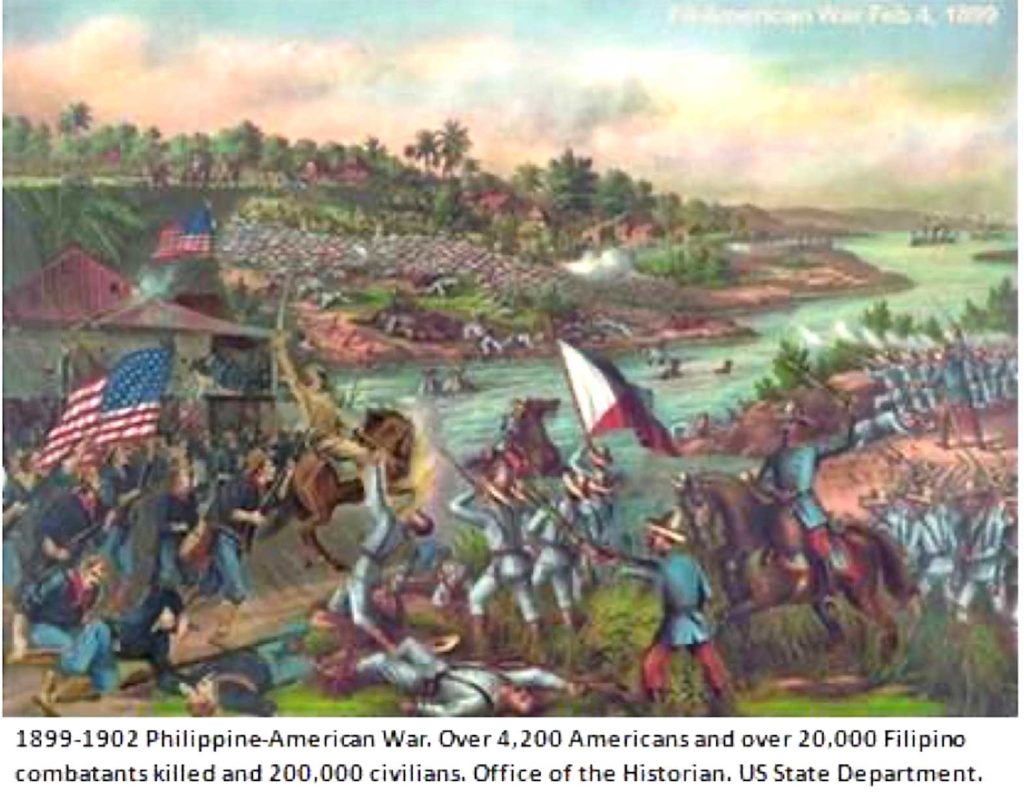Waking the Giant: 400+ years of exemplary Filipino presence in U.S. history, Part 2

In Part One of this 3-Part series, the question of HOW to awaken the five million Filipino Americans was raised.
The short answer lies in education, in shifting to a mindset that is grounded on self-esteem and pride of identity as a people. It involves the understanding of how centuries of foreign occupation in the Philippines had led to the squelching of our voice. It is acknowledging how the virtues and valor of Filipino Americans have contributed to U.S. nation-building in the last 400 years. It is seeing and realizing that today, our time has come!
As an initial exploration, we can divide the 400+ years of exemplary Filipino contributions in the U.S. into three distinct Episodes:
- Filipino Exploration and Settlements. The first 200 years from 1587-1763.
- Filipino Freedom Fighters. The second 200 years from 1812-2014. Seven historic military milestones defines this episode. The first three are covered in this Part 2 of the series: 1812-1861-1899. The next four military milestones are covered in Part 3 of the series.
- Filipino-American Valor and Leadership. The last 100+ years from 1899-2014, present time. This Third Episode helps define the present Fil-Am identity. Four military milestones of 1911-1941-1951-2014 and two key events on 1927-1930 and 1965 arecovered in Part 3 of this series.
1587-1763 Filipino Explorers and Settlers
Did you know that the first Filipinos landed more than 400 years ago, in what is now known as California? This was 34 years before the Plymouth Pilgrims celebrated Thanksgiving in 1621.
The year is 1587, October 17, when two intrepid Filipinos called “Luzon Men” where the first to set foot on shore, in what’s known today as Morro Bay, California. The Filipinos explored the area as crew members from the Spanish Galleon Nuestra Señora de Esperanza. After a few days, one of the Filipinos was slain by local inhabitants while exploring Morro Bay.
By 1763, thirteen years before the US Declaration of Independence, Filipinos had villages known as the Louisiana Settlement in Saint Malo. More settlements evolved in Louisiana to be known as the Manila Village in Barataria Bay.
1812-2014. Filipino Freedom Fighters
Filipinos fought alongside American Patriots against the British. From different sides, Filipinos served as Confederate and Union soldiers, as adversaries in the Philippine-American War, as allies in the Korean War, and now as Commanders and Generals in the US Military.
Filipino Freedom Fighters provide a unique perspective in their contribution to the evolution and development of the United States of America. It is a nation building journey of more than 200 years, from its inception, up to today’s superpower status.
In the1812 American War of Independence against the British “Manilamen” fought under the command of General Andrew Jackson in defense of New Orleans.
“Battle of New Orleans, where Filipino Americans, known as “Manilamen”, played a decisive role in 1815 in manning the artillery defenses, which allowed American forces to repulse enemy forces during the battle.”
1861 American Civil War. Filipino gallantry was demonstrated in both the Union and the Confederate Army.
Corporal Felix Cornelius Balderry, a Filipino-born in the Philippines served in the Union Army, with the 11th Michigan Volunteer Infantry Regiment, who fought in the siege of Atlanta.
1899 Philippine-American War
Many are not aware that the American icon and author, Mark Twain, was vehemently against the American incursion in the Philippines. It was a bloody war from 1899-1902, that killed 25,000+ combatants, (4,200-7,000 American and 20,000 Filipino). The civilian casualty and devastation due to the famine, disease, and genocidal hostilities of the war, were estimated to run from 200,000 to 1,000,000. This was an unimaginable 5-20% of the country’s 5 million population at that time. In the province of Samar occurred the Balangiga Victory by Filipinos, and the retaliatory Samar Massacre that ordered the province to be turned into a “howling wilderness…kill every one over 10”.
The imperialist and racist justification of President William McKinley was to occupy the Philippines and “civilize our little brown brothers.” This has been misrepresented as part of a $20-million colonial purchase of thr Philippines by the U.S. from Spain on December 10, 1898, in the Treaty of Paris. This marked the beginning of the U.S. as a global power.
The historical misrepresentation lies in the fact that six months earlier, the Philippines was already a sovereign nation. It had celebrated its Declaration of Independence from Spain on June 12, 1898. The Philippines is the First Constitutional Republic of Asia. What is usually omitted is that the Philippine Revolutionary Army already controlled the whole country from the occupying Spaniards; and had 15,000 troops surrounding the fort in Manila. The Treaty of Paris that ceded the Philippines to the US was illegal. Thus ensued the Philippine-American War which led to the US Commonwealth occupation of the Philippines until July 4, 1946.
Filipinos have had a pioneering and exemplary journey in exploring, living, and fighting for the democratic ideals of the United States, shoulder-to-shoulder, in most instances, with fellow Americans from 1587 to 1902. The conclusion of this 3-Part article will scan the highlights of the next 100+ years from 1901-2014; and explore how this has molded the Filipino American identity of courage and leadership.
Jorge “Jerry” Perez de Tagle, PhD, lives in the U.S. and the Philippines. He is an author, a change management practitioner and thought leader in the private and public sector. He taught at Syracuse University, New York and has his PhD in Social Change, Honoris Causa, and Candidacy in Organization Development.

